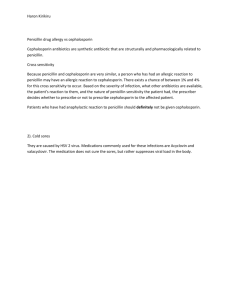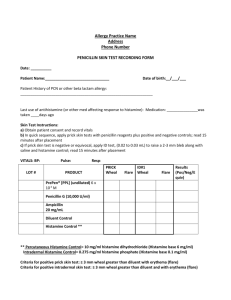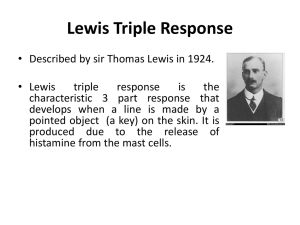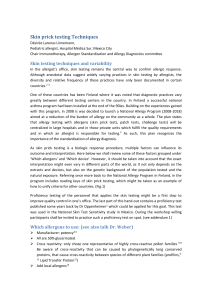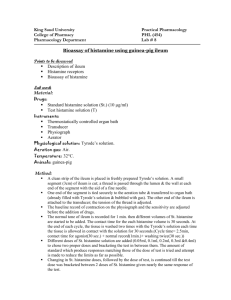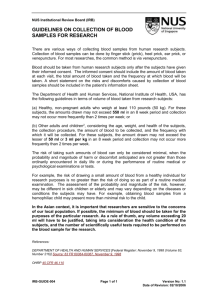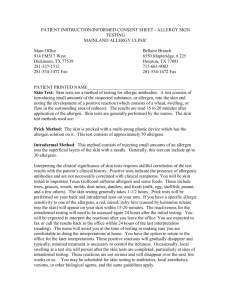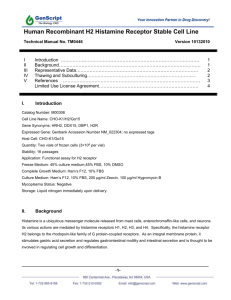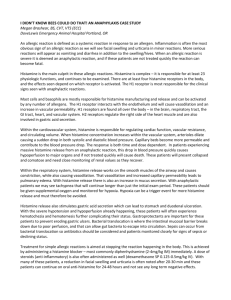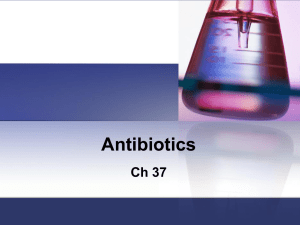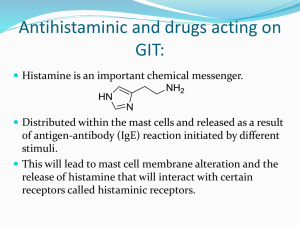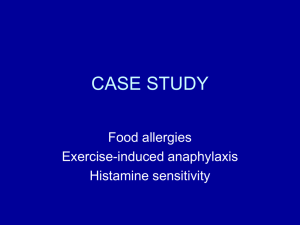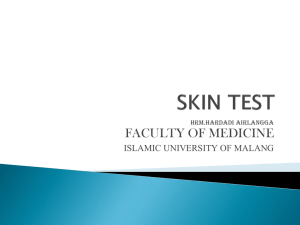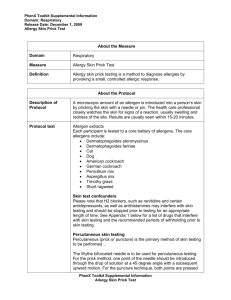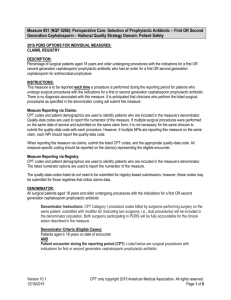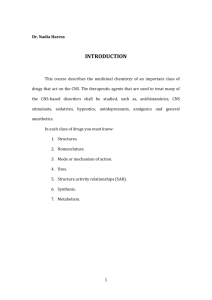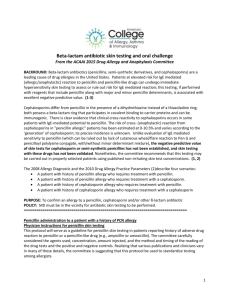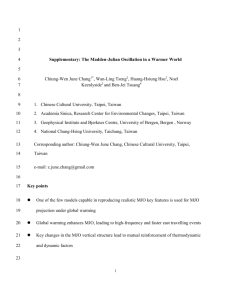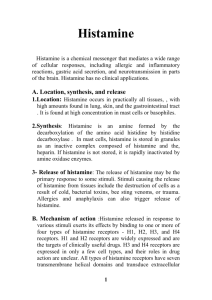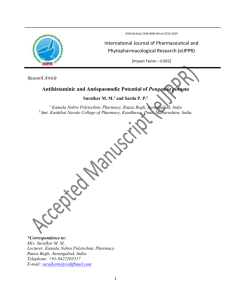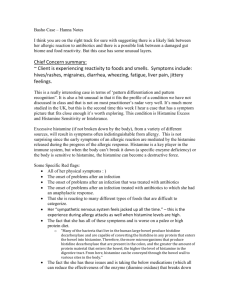Allergy Practice Name Address Phone Number CEPHALOSPORIN
advertisement
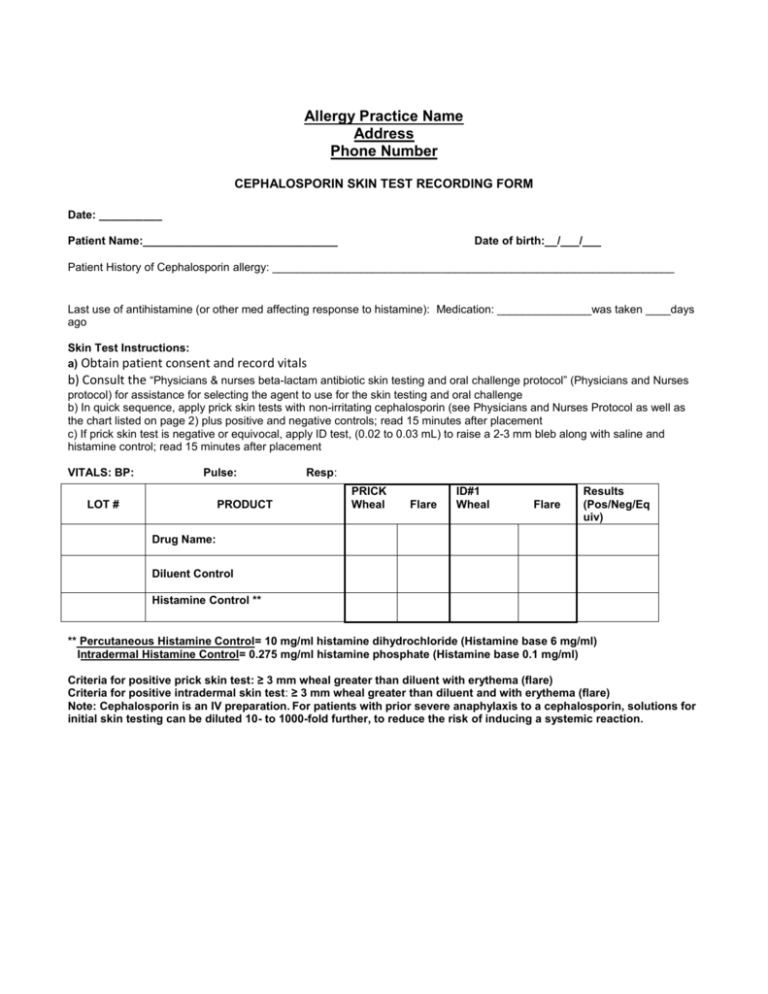
Allergy Practice Name Address Phone Number CEPHALOSPORIN SKIN TEST RECORDING FORM Date: __________ Patient Name:_______________________________ Date of birth:__/___/___ Patient History of Cephalosporin allergy: ________________________________________________________________ Last use of antihistamine (or other med affecting response to histamine): Medication: _______________was taken ____days ago Skin Test Instructions: a) Obtain patient consent and record vitals b) Consult the “Physicians & nurses beta-lactam antibiotic skin testing and oral challenge protocol” (Physicians and Nurses protocol) for assistance for selecting the agent to use for the skin testing and oral challenge b) In quick sequence, apply prick skin tests with non-irritating cephalosporin (see Physicians and Nurses Protocol as well as the chart listed on page 2) plus positive and negative controls; read 15 minutes after placement c) If prick skin test is negative or equivocal, apply ID test, (0.02 to 0.03 mL) to raise a 2-3 mm bleb along with saline and histamine control; read 15 minutes after placement VITALS: BP: Pulse: LOT # PRODUCT Resp: PRICK Wheal Flare ID#1 Wheal Flare Results (Pos/Neg/Eq uiv) Drug Name: Diluent Control Histamine Control ** ** Percutaneous Histamine Control= 10 mg/ml histamine dihydrochloride (Histamine base 6 mg/ml) Intradermal Histamine Control= 0.275 mg/ml histamine phosphate (Histamine base 0.1 mg/ml) Criteria for positive prick skin test: ≥ 3 mm wheal greater than diluent with erythema (flare) Criteria for positive intradermal skin test: ≥ 3 mm wheal greater than diluent and with erythema (flare) Note: Cephalosporin is an IV preparation. For patients with prior severe anaphylaxis to a cephalosporin, solutions for initial skin testing can be diluted 10- to 1000-fold further, to reduce the risk of inducing a systemic reaction. If skin test is negative, oral challenge to cephalosporin, which is the closest chemical structure to the agent, used for skin testing Oral Challenge Instructions: a) Give 1/10 of therapeutic PO dose of cephalosporin being challenged and monitor for signs and symptoms of a reaction for 30 minutes b) Give 9/10 of therapeutic PO dose of cephalosporin being challenged and monitor for signs and symptoms of a reaction for 60 minutes Note: For extremely severe reactions, consider 1/100, 1/10, and then full strength Time Vitals Dose of ___________ BP: Pulse: Resp: _______ mg PO BP: Pulse: Resp: _______ mg PO Symptoms Reaction YES/NO If yes, describe: ____________________________________________ Patient was negative on skin testing and oral challenge to this cephalosporin (_________________) and may take this drug in the future Patient is allergic to this cephalosporin (________________________) based upon skin testing or oral challenge and should avoid all types of cephalosporin unless further testing is completed Sample of previously published nonirritating concentrations of cephalosporins to be used for skin prick and intradermal testing. 1. 2. 3. Drug Previously Published Nonirritating Concentration* Cefotaxime 10 to 20 mg/mL1,2 Cefuroxime 10 to 20 mg/mL1,2 Cefazolin 20 to 33 mg/mL1,2 Ceftazidime 10 to 20 mg/mL1,2 Ceftriaxone 10 to 20 mg/mL1,2 Cephalexin 2 to 20 mg/mL3 Cefaclor 2 to 20 mg/mL3 Cefatrizine 2 to 20 mg/mL3 Empedrad R, Darter AL, Earl HS, Gruchalla RS. Nonirritating intradermal skin test concentrations for commonly prescribed antibiotics. J Allergy Clin Immunol 2003; 112:629. Testi S, Severino M, Iorno ML, et al. Nonirritating concentration for skin testing with cephalosporins. J Investig Allergol Clin Immunol 2010; 20:171. Romano A, Gaeta F, Valluzzi RL, et al. Diagnosing nonimmediate reactions to cephalosporins. J Allergy Clin Immunol 2012; 129:1166. From the ACAAI 2015 Drug Allergy and Anaphylaxis Committee
